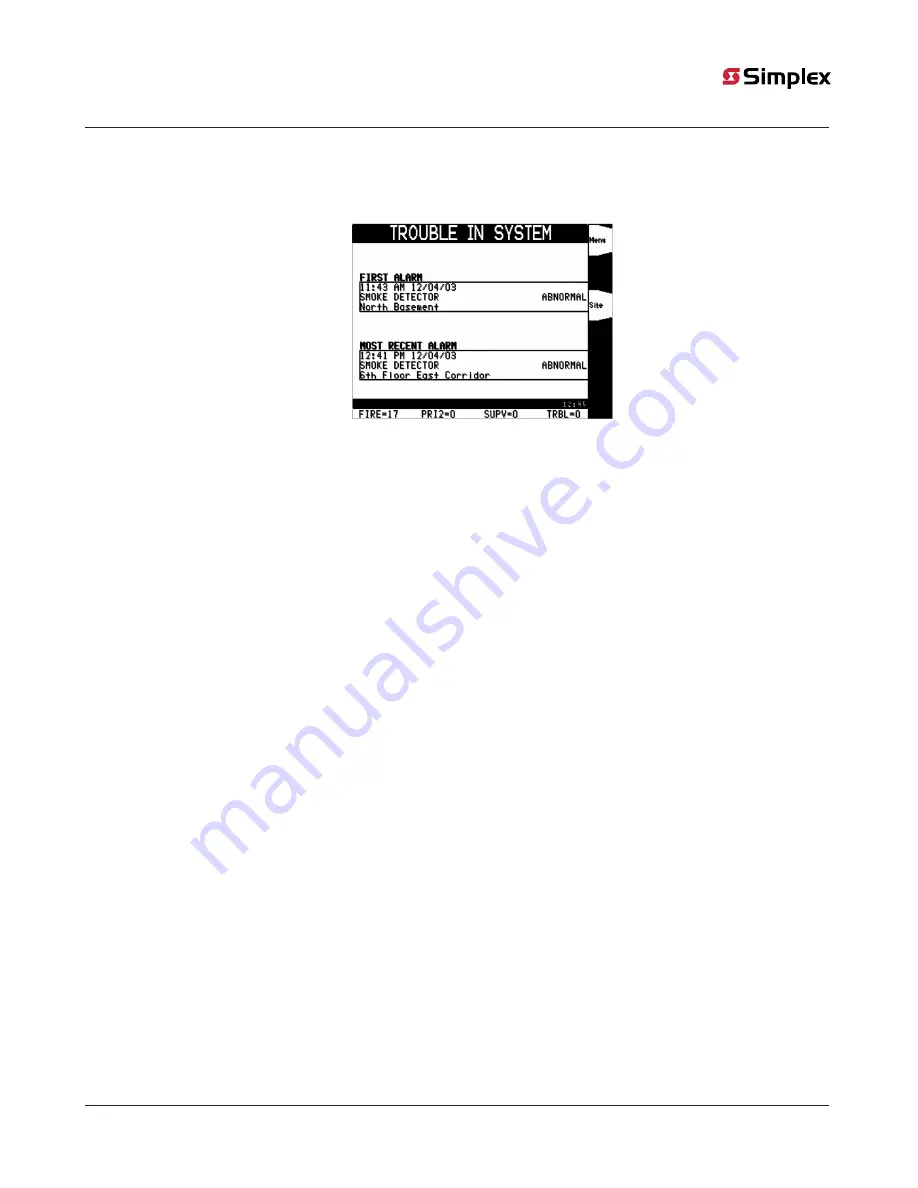
5.5 Individually Acknowledging Troubles
When individual acknowledge is used, the tone-alert re-sounds when the condition clears. Individual acknowledge must be selected if the
panel is providing proprietary receiving service in accordance with NFPA 72. Follow these steps to use individual acknowledge:
1.
Unlock and open the enclosure door. The display shows the trouble condition. For example:
Figure 20: Trouble Display
2.
Press the TROUBLE ACK key. An alarm list opens. Every flashing report indicates an unacknowledged trouble condition. Continue
pressing the TROUBLE ACK key and read- ing the reports until all reports have been acknowledged. Once all reports have been
acknowledged the tone-alert silences and the LED glows steady.
3.
Read the display. Investigate the trouble to determine its cause. Make necessary repairs in accordance with the manufacturer's
instructions. When the trouble clears, the Trouble LED flashes and the tone-alert sounds steady.
4.
Press the TROUBLE ACK key. The display shows the system status. Press the TROUBLE ACK key again. After a delay, the display
shows that the system status is normal.
5.6 If the Trouble Doesn't Clear
On global acknowledge systems, trouble points do not usually require acknowledgment of the cleared condition. If the system does
not clear, read the display. The information on the display will indicate the circuit or nature of the fault. Some faults interfere with the
protection provided by the Fire Alarm system. If the source of the trouble cannot be located, call an authorized Simplex representative to
repair the system.
5.6.1 System Reset Key
Some troubles latch until they are reset manually, or are reset by pressing the SYSTEM RESET key. Try pressing the SYSTEM RESET key if the
trouble is any one of the following:
• Class A initiating device circuit trouble
• City Circuit trouble
• 24 Point I/O trouble
If pressing the SYSTEM RESET key does not clear the trouble, or if the trouble toggles (clears and then reappears), the indicated circuit
should be checked by a qualified service technician.
5.7 Trouble Conditions
Trouble Indications for TrueAlarm Sensors
TrueAlarm devices are considered sensors instead of detectors because these devices do not determine alarm conditions. Instead,
the TrueAlarm smoke sensor is a measuring device that sends data regarding smoke density to the FACP. The TrueAlarm heat sensor
operates in a similar fashion, but it sends temperature data to the control panel instead of smoke density data. The FACP uses this data to
determine whether a trouble has occurred.
The TrueAlarm sensor has two automatic trouble indications. Either condition requires service by a qualified service technician.
•
Dirty
. A "Smoke Detector Dirty" condition is reported any time the average value on an individual sensor reaches a set threshold
value. The sensor continues to operate at the programmed alarm threshold.
•
Excessively Dirty
. A "Smoke Detector Excessively Dirty" trouble condition is reported any time the average value of an individual
sensor reaches a level such that full-range alarm detection is compromised. When a sensor is “excessively dirty,” the sensor will be
susceptible to false alarms.
In addition to the two automatic trouble conditions, the FACP software includes a pre-programmed digital pseudo point (P132, Sensor
Almost Dirty Log Enable) that can be selected through the ES Panel Programmer application. When selected, a system log entry is
page 17
579-685 Rev. D
InfoAlarm Operator’s Manual 4100U, 4100ES, 4010ES






























